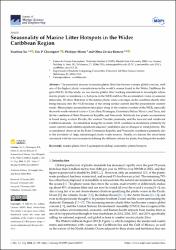/admin/item?itemID=b2007e3c-1b0e-49ed-8784-bf983c88f07a
Seasonality of marine litter hotspots in the Wider Caribbean Region

View/
Type of Access
OpenMaterial Type
ArticleType of Content
Scientific researchLanguage
EnglishCollection
- Investigación ambiental [1759]
Metadata
Show full item record| Abstract: | The persistent increase in marine plastic litter has become a major global concern, with one of the highest plastic concentrations in the world’s oceans found in the Wider Caribbean Region (WCR). In this study, we use marine plastic litter tracking simulations to investigate where marine plastic accumulates, i.e., hotspots, in the WCR and how the accumulation varies on seasonal timescales. We show that most of the marine plastic waste converges on the coastlines shortly after being released into the WCR because of the strong surface current and the predominant easterly winds. Major plastic accumulations take place along (i) the western coastline of the WCR, especially the north–south-oriented coasts of Costa Rica/Nicaragua, Guatemala/Belize/Mexico, and Texas, and (ii) the coastlines of Haiti–Dominican Republic and Venezuela. Relatively low plastic accumulation is found along western Florida, the western Yucatán peninsula, and the leeward and windward Caribbean islands. Accumulation along the western WCR coastlines is modulated primarily by ocean currents and exhibits significant seasonal variabilities due to changes in wind patterns. The accumulation observed on the Haiti–Dominican Republic and Venezuela coastlines is primarily due to the proximity of large, mismanaged plastic waste sources. Finally, we discuss the uncertainty associated with the choices made in defining the different criteria for plastic beaching in the models. |
| Author(s): | Xu, Xiaobiao
Chassignet, Eric P. Miron, Philippe Zavala-Romero, Olmo |
| Date: | 2024 |
| Published: | Journal of Marine Science and Engineering, 12(2), 319 |
| Citation: | Xu, X., Chassignet, E. P., Miron, P., & Zavala-Romero, O. (2024). Seasonality of marine litter hotspots in the Wider Caribbean Region. Journal of Marine Science and Engineering, 12(2), 319. Recuperado de: |
| URI: | https://bvearmb.do/handle/123456789/5188
|

